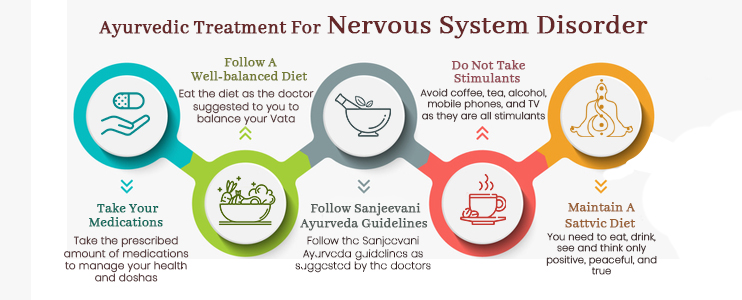OVERVIEW
The most eminent system of the body is the Nervous System that controls all body activities. It comprehends two parts of the central nervous system: the spinal cord & brain, and the peripheral nervous system: additional neural parts. Every bodily function is systematized by the Nervous System, so any problem in it will affect the daily regime of the person. Ayurvedic treatment as per the doshas is suggested by our expert practitioner to address the root cause of the problem. Let’s talk you through some of the common ailments, causes, and symptoms interconnected to the nervous system.
Best Cure With No-Side Effects
Dr. Ravindra Vatsyayan is a well-known Ayurvedacharya with more than 45 years of experience in Ayurveda. He is a pioneer in giving custom-made Ayurvedic treatments to his patients who travel to him for the entire world. His treatment approach and the way to understand the root cause of the problem is what makes him different and best in this field.
WHAT ARE THE MOST COMMON DISEASES RELATED TO THE NERVOUS SYSTEM?
|
|
|
|
|
|
|
|
|
|
|
If you are diagnosed with any of this condition or having trouble getting the best treatment option then schedule your online Ayurvedic Treatment Consultation with us.
WHAT ARE THE MOST COMMON CAUSES WHICH LEAD TO NERVOUS WEAKNESS?
|
|
|
|
|
|
WHAT ARE THE SYMPTOMS OF NERVE WEAKNESS?
Some of the sensory symptoms are mentioned-below:
|
|
|
|
|
|
|
Some of the motor symptoms are:
|
|
|
|
|
-
HEADACHE/MIGRAINE
Headache in Ayurveda is termed as ‘Shirahshool’. It is one of those health issues which occurs in people’s life at least once. The problem is characterized by pain in the head. The disorder in which headache is the prime reason is termed as ‘Shiroroga’. As per Ayurveda, migraine is a part of suryavarta and ardhavabhedaka. In the Madhava Nidanam which is an authentic ayurvedic text of diagnostic moves, migraine has been described as a severe and debilitating headache arising usually in half portion of the head which may include any area of temporal, frontal, eyeball, and vertex region. The suryavarta type of headache more or less depicts a headache that occurs according to a schedule. Ayurveda offers a very successful treatment for headaches and migraines.
WHAT ARE THE REASONS FOR HEADACHE?
|
|
|
|
|
|
|
AYURVEDIC TREATMENTS FOR HEADACHE
As per Ayurveda, the headache is caused due to a problem with the nervous system and affects the digestive system. As the body energy keeps going down, the body is not able to fight the problems. Eventually, it leads to toxin build-up which leads to headaches. If your diet is unbalanced then it can trigger pitta dosha. A combination of all these will lead to a headache. Ayurvedic treatment for headaches will help to give you relief from pain and help to treat it from the root cause. The treatment will help your nervous system to calm down and help in balancing the pitta dosha.
-
STROKE
Stroke is a common nervous system issue that affects the limbs, trunk, and face on one side or either side of the body. As per Ayurveda, it is linked to pakshaghata. If the vata gets aggravated then srotas and snayu will become dry. With this condition, the body is not able to function properly and it results in loss of sensation.
AYURVEDIC TREATMENT FOR STROKE
Under the treatment approach, the doctor will first address the root cause of paralysis and then the nervous system is strengthened. The patient must take proper care of themselves when they have hypertension, dyslipidemia, diabetes, and heart disease. Vasti is the first treatment approach for paralysis patients. Brimhana (Nasya) is suggested to the patients as it is nourishing.
-
EPILEPSY
It is a neural disorder in which the brain makes people suspected to have unusual sensations, seizures, and sometimes they lose consciousness. The prevalence of this disorder is present in all age groups. Statistics have shown that 2.2 million Americans are diagnosed with epilepsy.
When the normal functioning of the nerve cells is obstructed, it is likely to cause seizures. This can be the result of low blood sugar, drug, or alcohol withdrawal, or high fever.
When the person has 2 or more seizures, then this medical condition is termed epilepsy. The occurrence of epilepsy is due to different reasons like brain damage due to injury or health issues, stroke, tumor, or imbalance of the nerve-signaling chemicals.
In some cases, there is no reason behind epilepsy. Ayurveda has a correct treatment approach for this condition that includes herbomineral medicines and Panchakarma.
AYURVEDIC TREATMENT FOR EPILEPSY
In case, the reason for epilepsy is due to the extrinsic factor which affects the mental balance of the patient then the treatment plan includes the:
- Meditation
- Counseling
- Yoga
- Mantras
In case the apasmara happens due to vitiated doshas then the doctor will suggest you get panchakarma therapies like:
- Vamana
- Virechana
- Vasti
- Nasya
For strengthening and rejuvenating the nervous system the doctor will suggest you get:
- Shirodhara
- Thakradhara
- Sirolepam
- Shiropichu
-
MULTIPLE SCLEROSIS (MS)
Multiple sclerosis is a persistent disease of the nervous system. The problem is associated with the autoimmune disorder, which means the body starts attacking itself. Every patient diagnosed with MS is affected differently. The symptoms can range from mild to severe.
WHAT PROBLEMS OCCUR DUE TO MS?
The problem can reach the stage that a person loses their finesse to speak, walk, write, or see. All this happens as the brain, and other body parts cannot communicate with each other. Timely analysis of your condition with the Ayurvedic approach has helped thousands of patients.
-
CERVICAL RADICULOPATHY
If the nerve functions are damaged then the cervical spine nerve roots may be compressed which results to:
- Pain
- Loss of sensation (arm and hand)
- Muscle weakness and Numbness
- Altered sensation
- Lack of coordination
- Tingling Sensation
The area in which the nerve is damaged will also make a lot of difference. So, you should consult the doctor and understand which treatment option is best suited for you.
AYURVEDIC TREATMENT FOR CERVICAL RADICULOPATHY
Our Ayurvedic practitioner will suggest to you the treatment plan to address the reason behind the nerve damage. The most preferred treatment plan in Greevavasthi. Apart from these, the doctor will perform abhyangam, pizhichil, swedanam, lepam, and potali treatments
-
ATAXIA
Ataxia is categorized by a lack of muscle control. Voluntary movements lose coordination that impacts walking and balance. The problem troubles the legs, body, hands, arms, speech, fingers, and eye movement. The reasons behind ataxia are nerve damage, stroke, alcoholism, multiple sclerosis, tumors, metabolic disorders, and vitamin deficiency. Ayurvedic diagnosis and treatment will depend on the reason for Ataxia.
AYURVEDIC TREATMENT FOR ATAXIA
For the Ataxia condition, our Ayurvedic practitioner prefers the samtarpana nourishing treatment. Due to this condition, the body starts to decay at a high pace. So that to bring back the nourishment to the body this treatment is the most preferred one. A doctor will suggest you the particular treatment plan for this condition and 4 treatment sessions are planned for the treatment which includes:
- First Session of Panchakarma – 21 days
- Second Session – 15 Days
- Third Session – 15 Days
- Fourth Session – 8 Days
-
ALZHEIMER’S DISEASE
Alzheimer’s is an intensifying ailment, and its occurrence has been noted in individuals above 65. Nevertheless, the problem also affects people below 65 who have untimely symptoms. Around 2/3rd of the patients are women. At the advanced stage, the problem will affect the ability to learn, and exhibit skills. Ayurvedic treatment at the very beginning will let go of the symptoms.
AYURVEDIC TREATMENT FOR ALZHEIMER’S DISEASE
With an Ayurvedic treatment plan, the doctor suggests you use herbs that have the same kind of effect as Medhyarasayna. In addition, the Panchkarma is suggested to improve the quality of life of the patients.
-
PARKINSON’S DISEASE/ PARALYSIS/FACIAL PARALYSIS
Parkinson’s Disease/ Paralysis/Facial paralysis are grouped under Vata Roga. As per Ayurveda, these are degenerative disorders that result in loss of muscle coordination and muscle weakness. The ayurvedic practitioner provides medicine, skilled management, and panchakarma procedure to counter this problem.
AYURVEDIC TREATMENT FOR PARALYSIS
The main treatment plan suggested by the Ayurvedic treatment for paralysis is clearing the blocked channels which help to make the motor and sensory function. If there is problem with the motor function then it is likely to results in:
- Reflexes
- Tremor
- Loss of Muscle tone
- Cognitive functions
Following a specialized treatment plan will help to address the internal and external problems with this condition.
WHAT TYPE OF DIET PLAN DO YOU NEED TO FOLLOW TO STRENGTHEN THE NERVES?
During the treatment course, the doctor will suggest to you the treatment plan to increase the nerve strength. A nutritionally balanced diet is important to eradicate the issue of nerve weakness. Here are some of the food options which you need to include in the diet.
Include Green leafy vegetables as they are a great source of:
|
| Include avocado and broccoli in your diet as they greatly strengthen the brain nervous system. |
Make sure to include pumpkin seeds, nuts, and almonds in your diet as they are a great source of:
|
WHAT CHANGES TO MAKE IN YOUR LIFESTYLE FOR STRENGTHENING THE NERVES?
- Do not smoke and drink alcohol
- Avoid junk, fried, and oily food
- Do not eat non-vegetarian food
- Take out some time and do some breathing exercise & yoga asanas
- Make sure to get enough rest during the day.
Success Story of a Patient Treated At
Dr. Vatsyayan’s Sanjivani Ayurvedshala
Kaira Sharma, Chandigarh
I was diagnosed with Multiple Sclerosis 2 years back before my sister’s marriage and it made it difficult for everyone to manage the situation. It was the most difficult time of my life. There was a time that I had to use a walker for assistance and everyday pain increased.
One fine day, my sister and I tried to research the best doctor and treatment. The online research helped us to come across Dr. Vatsyayan’s Sanjivani Ayurvedshala. At this point, I was at the stage of secondary progressive multiple sclerosis.
The day I consulted the doctor Dr. Vatsyayan’s Sanjivani Ayurvedshala, it was the start of my journey to miracle recovery. The doctor consulted me with such great enthusiasm and positivity that it helped me to gain my confidence back. The herbal massage and other Ayurvedic therapies specifically designed for my condition helped me feel amazing. I started seeing a decrease in the severity of symptoms, and my energy levels were extremely high. It has been 7 months since I have been consulting the doctor, and I am feeling myself again.
Are you having trouble?
Schedule your initial consultation with our doctor and get a tailored-made solution for your condition & notice a difference in your condition right away.

